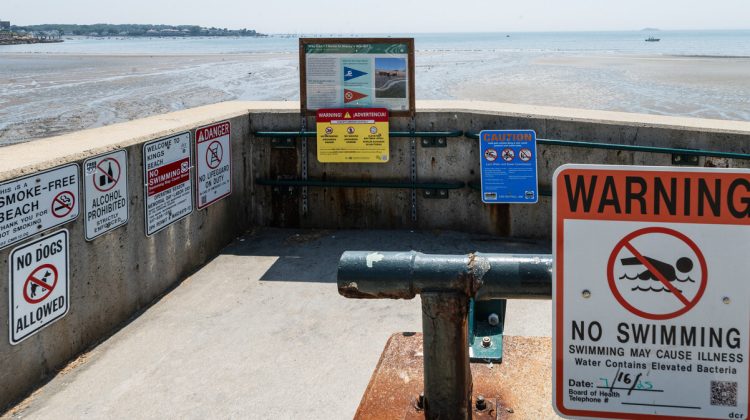SWAMPSCOTT — With the flagging system at King’s Beach used to alert community members on whether or not the water quality is safe to swim in having a 24-hour delay, residents are left wondering about the accuracy of the system, and whether a blue flag means it’s actually okay to swim.
Water quality is monitored daily at King’s Beach — which is operated by the state Department of Conservation and Recreation (DCR) — for recreational swimming throughout the summer season. Daily samples are collected at three sites on the beach by the Massachusetts Department of Public Health: Kimball Road, Pierce Street, and Eastern Avenue in Lynn, according to the King’s Beach Website. Depending on the results, one of two flags are placed along the Lynnway: blue flags mean it’s safe to swim, and red flags mean it isn’t.
The DPH also runs the Interactive Beach Water Quality Dashboard, which community members can check out at: https://www.mass.gov/info-details/interactive-beach-water-quality-dashboard.
However, following the sampling, it takes at least 24 hours for the results to be reported via email to DCR beach operators. When the beach operator then flags the beach accordingly as safe or unsafe for swimming, it is based on the prior day’s water quality.
“Due to the time delay between when a sample is taken and the results are published, the decision informing which flag to fly on the beach is based on inaccurate information. In the 24+ hours that occur between the two events, at least two tidal cycles have occurred, making entirely new water fill the space,” according to kingsbeachma.com (which run by Save The Harbor).
Another element of the situation is the fact that when it rains, the water quality decreases due to the stormwater runoff into local bodies of water that “contaminates [the water] with whatever bacteria or toxins it has picked up along the way.”
Former Water and Sewer Advisory Committee Chair Liz Smith, who is still involved in the UV pilot at King’s Beach, spoke on her concerns about the flagging system.
“It’s a really tricky situation. Oftentimes, the test result reflects what the water was doing yesterday, and by today, it could be completely clean, but the flags have to be based on the results from the day before,” Smith explained. “It means there’s days when the beach isn’t open when it probably could be … and I think the Department of Public Health feels that it’s better to be overly cautious than to risk people getting sick.”
Smith continued, “They warn people to stay out of the water for 24-48 hours after significant rain because we know that it pushes bacteria into the system. … What I’m more concerned about, frankly, is that because we have to wait 24 hours, sometimes we don’t tell people that the beach is closed soon enough.”
Smith recalled a day several weeks back when heavy rainfall started at 9 a.m., but the testing had been done at 7 a.m. “The beach was open, and it didn’t close until the following day because that initial reading was too early,” she said. “I think it’s not an easy answer, and I think it could be improved upon, and improving it would require some complexity.”
Amour spoke with The Daily Item on Wednesday afternoon and explained the flagging system.
“I think it’s important for the public to realize that blue conditions today don’t necessarily reflect the actual water quality in the water, and it’s more important to look at the historical trend for a beach to determine if the body of water’s safe to swim in,” Amour said. “When folks ask me if it’s okay to swim at King’s Beach, my answer, still, despite the UV pilot system, is ‘no.’”
She said she’s gotten a lot of questions about why the flags at the beach are still red and general confusion about the way the system works. “Even if the UV system is on and working, there still might be one area of the beach, whether it’s Pierce Avenue, Kimball Road, that tests above the safe limit … and any time one of those areas test above the safe limit, the entire beach is closed,” she said.
She added, “Even though we might be seeing positive effects of the UV treatment on Stacy’s Brook itself, there’s still runoff going into the beach through outlets along Lynn Shore Drive.”
Save the Harbor/Save the Bay Executive Director Chris Mancini said the organization would like to see an update or change to the current flagging system, but it would have to work with multiple state agencies in order to see that through.
“They were effective in the old days, but the red flags are not effective in real time communication,” Mancini said about the flags educating and warning the community.
“We’re committed to being as transparent as possible with our residents regarding water quality. We acknowledge the limitations of the current flag system, as documented by Save the Harbor/Save the Bay, and we’re actively working with stakeholders to both enhance water quality and ensure these risks are communicated clearly and effectively,” Mayor Jared C. Nicholson said. “We deeply appreciate the efforts of the Department of Public Health, Liz Smith, Matt Pelland, and our summer interns for their invaluable work on data and sampling.”


